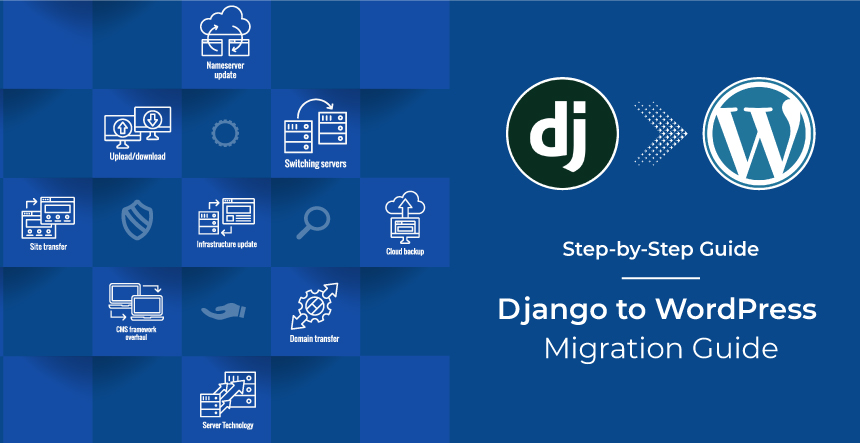




Django to WordPress migration is an interesting subject, but first, we will dive into some contextual details. Websites need to be revamped depending on the demand of the business and the evolving technologies. Modern-day websites have a personalized character to suit the brand. WordPress has a reputation for offering the highest levels of customization and therefore, site owners choose to migrate to WordPress. Django to WordPress migration is an intelligent step if you want to enhance your website and add more features to it. While both CMSs have their loyal fans and merits to their credit, people still choose WordPress over other CMSs.
Let us help you with a guide that lists the steps of Django to WordPress migration.
The Power of Django V/S the Ease of WordPress: A Head-to-Head Comparison
Wix to WordPress Migration Guide
Drupal to WordPress Migration Guide
Sitecore to WordPress Migration Guide
SQUARESPACE to WordPress Migration Guide
Django is an open-source CMS with built-in support for multilingual websites. It allows you to publish content with a sophisticated architecture and hierarchical content structure. It offers front-end content editing and multisite support to create techno-savvy web applications. Easy to integrate with other applications, the CMS also has adequate community support. Excellent for eCommerce sites and high on security, the CMS is quite simple to use. It is used by popular names like Instagram, Spotify, L’Oreal, etc. With all these benefits, it also has certain limitations in terms of flexibility, performance, design elements, and more. These factors make it less reliable than user-friendly CMSs like WordPress.
WordPress is the most popular CMS in use today, and rightfully so. It offers plenty of benefits over its contemporaries and proves to be a beginner-friendly CMS. Commenced as an open-source blogging platform, the CMS has technically evolved into a platform that offers enterprise-level web applications. You can create a simple blog to a fully featured website with WordPress. Also, it is suitable for people with the least technical knowledge.
WordPress offers thousands of themes and plugins to add diverse functionalities to any website. With WordPress, you have numerous tools to manage content and new features on the website. Contrary to that, Django requires some technical knowledge of Python and Linux to create features that need to be built from scratch.
Being a versatile CMS, WordPress reduces application development time to the bare minimum. You can customize every feature in the shortest possible time. Unlike this, Django requires elaborate planning and time to develop any application.
WordPress backs 43% of global websites and has an active developer community that comes up with regular updates. You have active community support from the global WordPress community that does not let you struggle for long. Any doubt or query gets resolved through the community. On the other hand, Django CMS has only 0.1% of users and a lower market share. This also hints that it is less evolved than the mighty WordPress.
WordPress takes care of 80-90% of Google issues and has built-in SEO features. This gives your WordPress site a clear pathway to higher rankings on search engines. Unlike this, Django has limited support for SEO.
Consider website continuity as the prime requisite. Site owners need to be prepared that the site may not be available during the migration process. Users of the site should be informed about this to avoid losing out regular or potential customers.
Inspect the Django site to prepare a list of components that need migration. The rest, especially the obsolete ones, should be dropped off to create a better, relevant website. A site audit is a must to know what needs to move during Django to WordPress migration.
If you want a new domain, then prepare for it before beginning the migration process. The web development team should do this proactively.
Take a backup of the entire Django site to avoid losing out on any data. Back up every essential element, component, and data for a streamlined migration process.
Make sure that your ranking is not lost during the migration period. For this, keep a keen eye on the SEO efforts and duplicate them for the new site. Remember, rankings are directly proportional to sales and revenue, so, carry the SEO structure to the new site.
Take care of the FTP credentials and WordPress installation on the new domain to enjoy a hassle-free migration.
With all these aspects rightly covered, let us now move on to the actual migration process. Let us walk you through every step to make things easy for you.
First and foremost, it is important to evaluate the existing Django site so that you can pick and choose what you want to move to the WordPress site. Choose the elements that are required, be it files, databases, icons, images, and other site components. At this time, you can remove or let go of the obsolete components. Migration could be challenging in terms of time, so thorough site analysis and selection of components to move will make things convenient. It will also save time.
If you are choosing a new hosting service, then make sure it is WordPress-specific. It will automatically install WordPress, your team needs to configure the user accounts and customize themes, navigation structure, etc. At this stage, WordPress developers can customize themes, plugins, and styles and configure them as per business requirements.
Next, import all the data including files, themes, images, databases, and content onto the WordPress instance. This is a crucial step as you cannot lose out on any important data. Therefore, it is advisable to hire WordPress developers who master the CMS migration process. They have the experience and expertise to create a foolproof website that remains stable in the future.
Post the migration process, it is significant to quality-check all the components of the newly formed WordPress website. Check everything from design, utility, SEO, plugins, etc. Monitor if there is any data loss and execute the needful steps. Check the performance of the website to see if it’s up to the mark or not.
It is a brainy step to go for Django to WordPress migration. As WordPress offers higher performance, flexibility, plugins, functionality, design, etc. it will benefit the business in the long run. It will also earn higher rankings, sales, and ROI.
If you are a Startup, SME, or Enterprise looking for WordPress developers that perform seamless migration services, then KrishaWeb could be the best technology partner for you.
Feel free to connect for further discussions and details!
Subscribe to our newsletter and learn about the latest digital trends.